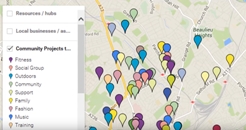 What makes your neighbourhood work?
What makes your neighbourhood work?
Asset-Based Community Development (ABCD) is not a new concept. About 40 years ago, John McKnight and Jody Kretzmann, took a four-year learning journey, visiting twenty cities and talking to 2,000 people in neighbourhoods which culminated in the book, Building Communities From the Inside Out: A Path Towards Finding and Mobilizing a Neighborhood’s Assets. They wanted to discover if people knew who lived on their block and if they do things together. From this journey, 125,000 books have been sold and a movement was created.
Asset-Based Community Development (ABCD) is different from other community development models. An article by John McKnight and Cormac Russell called Four Essential Elements of an Asset-Based Community Development Process defines these differences. It highlights four key elements to an asset-based community development process that other community development models do not require:
1. Resources
There are six assets or resources which are used to enhance local wellbeing in every sense of the term:
-
Contribution of Residents
-
Associations
-
Local Institutions
-
Local Places
-
Exchange
-
Stories
2. Methods
This involves identifying and productively connecting unconnected local resources:
-
Starting with what residents can do themselves as an association of citizens, without any outside help
-
Next, looking at what they can do with a little outside help
-
Finally, once these local assets have been fully connected and mobilized, citizens decide collectively on what they want outside agents to do for them
3. Functions
Involves seven functions that are critical features of all home-based natural communities.
-
Enabling Health
-
Assuring Security
-
Stewarding Ecology
-
Shaping Local Economies
-
Contributing to Local Food Production
-
Raising our Children
-
Co-Creating Care
4. Evaluations
Evaluating the extent to which citizens are engaged with the first three essential elements. This process of engagement is not about auditing, but about learning, and making mid-course corrections that allow the community to stay committed to their cultural calling. The four evaluation principles are:
-
Identifying the maximization of gift exchange
-
Identifying the maximization and deepening of associational life
-
Identifying the maximization in the number of participating and co-producing residents and the increase in their citizen power.
-
Placing a particular emphasis on the inclusion of those who have been marginalized.
Sponsors of ABCD processes ensure that associated evaluations actively conform to the preceding three principles.
The article concludes that for a community development process to be called Asset-Based Community Development it requires all four of the above elements at some point in the development process.
Watch this 3 minute video:
For more resources on ABCD and support in developing an asset based community, contact Nuture Development.
See also a previous blog, Sustainable community development: from what's wrong to what's strong.
Retweet about this article:
From information by ABCD, 11/06/2019